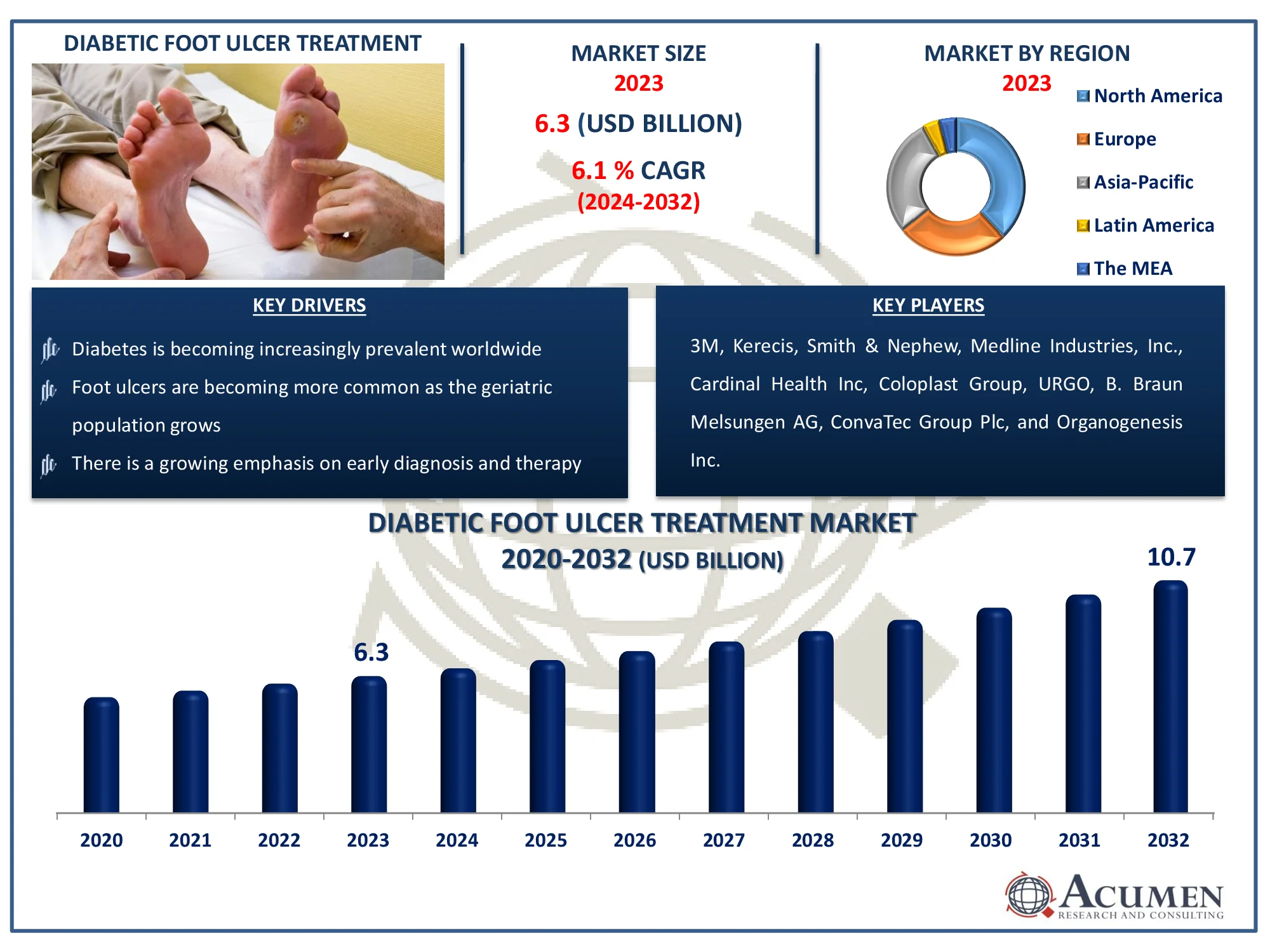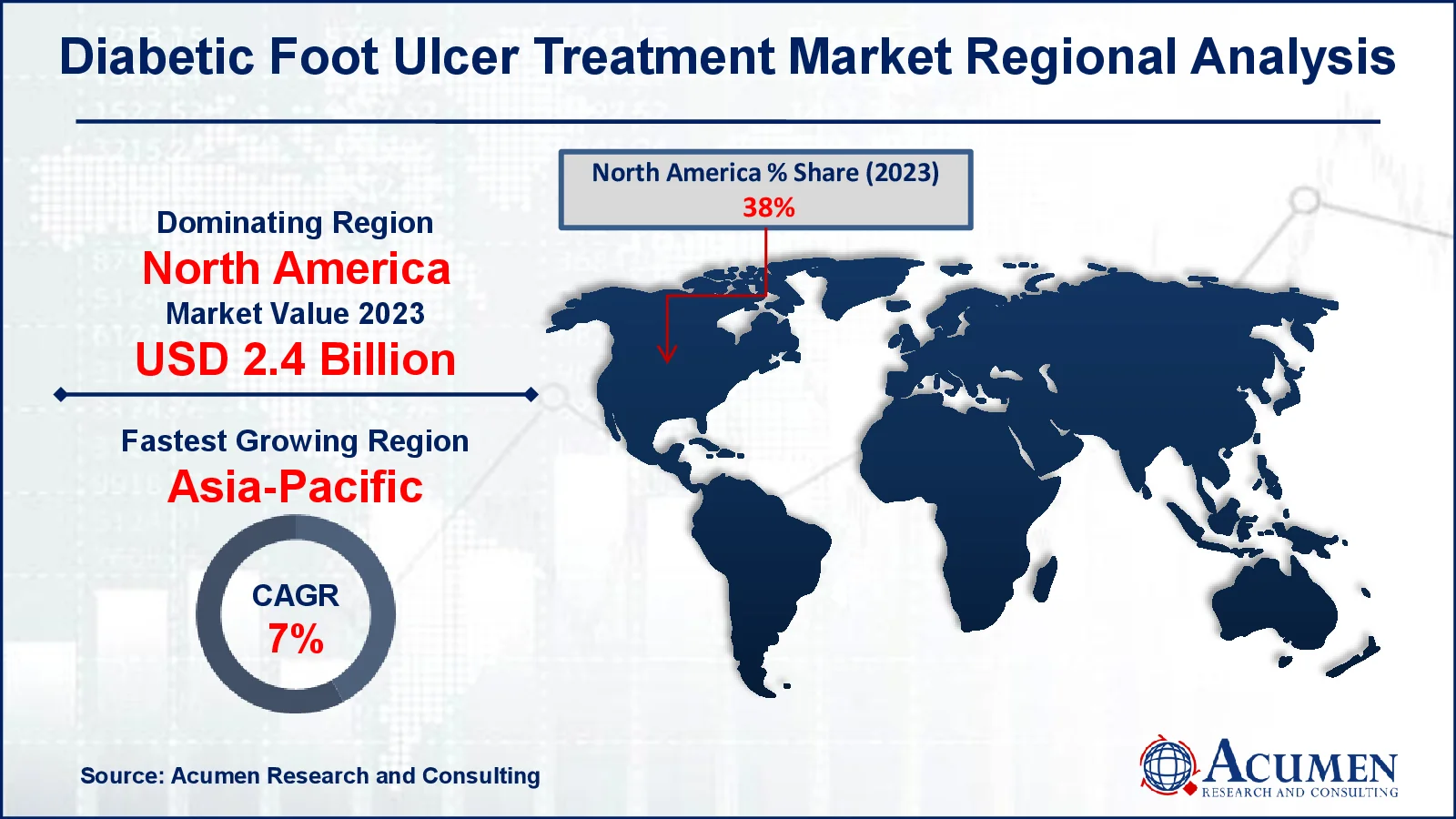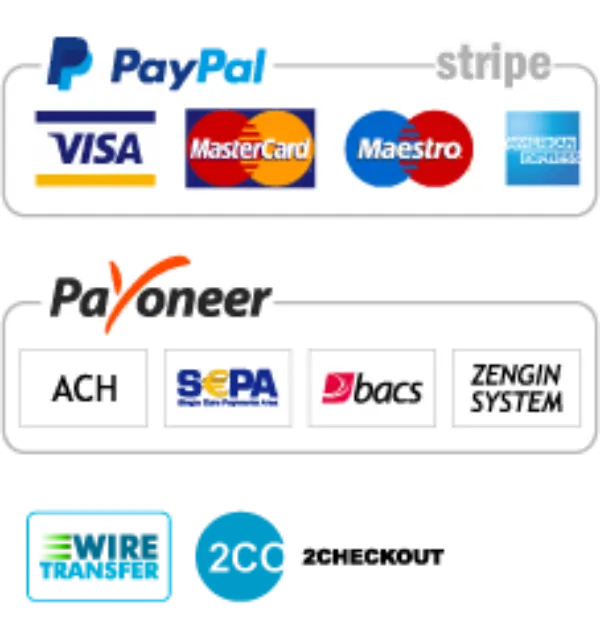Diabetic Foot Ulcer Treatment Market Size - Global Industry, Share, Analysis, Trends and Forecast 2024 - 2032
Published :
Report ID:
Pages :
Format :
Diabetic Foot Ulcer Treatment Market Size - Global Industry, Share, Analysis, Trends and Forecast 2024 - 2032
Report Coverage
- Industry Dynamics
- Market Size and Forecast Data
- Segment Analysis
- Competitive Landscape
- Regional Analysis with a Niche Focus on Country-Level Data
- High Level Analysis - Porter's, PESTEL, Value Chain, etc.
- Company Profiles of Key Players
- Option to Customize the Report As Per Your Specific Need
Request Sample Report
The Global Diabetic Foot Ulcer Treatment Market Size accounted for USD 6.3 Billion in 2023 and is estimated to achieve a market size of USD 10.7 Billion by 2032 growing at a CAGR of 6.1% from 2024 to 2032.
Diabetic Foot Ulcer Treatment Market Highlights
- Global diabetic foot ulcer treatment market revenue is poised to garner USD 10.7 billion by 2032 with a CAGR of 6.1% from 2024 to 2032
- North America diabetic foot ulcer treatment market value occupied around USD 2.4 billion in 2023
- Asia-Pacific diabetic foot ulcer treatment market growth will record a CAGR of more than 7% from 2024 to 2032
- Among treatment, the biologics sub-segment generated more than USD 2.3 million revenue in 2023
- Based on end-use, the hospitals sub-segment generated around 34% market diabetic foot ulcer treatment share in 2023
- Growing demand for home-based care options is a popular diabetic foot ulcer treatment market trend that fuels the industry demand

A diabetic foot ulcer is a serious ailment that diabetics can get. Poor blood circulation and nerve damage in the feet cause open sores. These ulcers might develop infected, causing major problems if not treated promptly. The treatment's purpose is to avoid infection, promote healing, and relieve pressure on the ulcer. This can include specialized footwear, wound care, antibiotic-based infection treatment, and, in severe cases, surgery. Effective blood sugar regulation is essential for recovery since high blood sugar levels might hinder the body's natural healing process. Furthermore, addressing any underlying circulation issues is crucial for boosting blood flow to the affected area. Early detection and treatment are crucial for minimizing complications and speeding up recovery.
Global Diabetic Foot Ulcer Treatment Market Dynamics
Market Drivers
- Diabetes is becoming increasingly prevalent worldwide
- Foot ulcers are becoming more common as the geriatric population grows
- Advances in wound care technology
- There is a growing emphasis on early diagnosis and therapy
Market Restraints
- High cost of advanced treatments
- Limited access to care in developing regions
- Lack of skilled healthcare professionals
Market Opportunities
- Growth in emerging markets
- Creation of novel wound care products
- Growing investment in R&D
Diabetic Foot Ulcer Treatment Market Report Coverage
| Market | Diabetic Foot Ulcer Treatment Market |
| Diabetic Foot Ulcer Treatment Market Size 2022 |
USD 6.3 Billion |
| Diabetic Foot Ulcer Treatment Market Forecast 2032 | USD 10.7 Billion |
| Diabetic Foot Ulcer Treatment Market CAGR During 2023 - 2032 | 6.2% |
| Diabetic Foot Ulcer Treatment Market Analysis Period | 2020 - 2032 |
| Diabetic Foot Ulcer Treatment Market Base Year |
2023 |
| Diabetic Foot Ulcer Treatment Market Forecast Data | 2024 - 2032 |
| Segments Covered | By Ulcer Type, By Treatment, By End-Use, And By Geography |
| Regional Scope | North America, Europe, Asia Pacific, Latin America, and Middle East & Africa |
| Key Companies Profiled | 3M, Kerecis, Smith & Nephew, Medline Industries, Inc., Cardinal Health Inc, Coloplast Group, URGO, B. Braun Melsungen AG, ConvaTec Group Plc, and Organogenesis Inc. |
| Report Coverage |
Market Trends, Drivers, Restraints, Competitive Analysis, Player Profiling, Covid-19 Analysis, Regulation Analysis |
Diabetic Foot Ulcer Treatment Market Insights
The diabetic foot ulcer treatment market is primarily driven by the increasing global incidence of diabetes. Diabetes, a chronic metabolic illness marked by high blood sugar levels, frequently causes nerve damage (neuropathy) and impaired blood circulation in the foot. These factors promote the development of foot ulcers. As the diabetic population grows, so will the danger of complications such as foot ulcers. This growing patient population boosts demand for preventative, diagnostic, and treatment options, resulting in market growth. The high cost of diabetic foot ulcer care severely restricts market expansion. Advanced wound care products, customized footwear, and surgical procedures can be costly for both individuals and healthcare systems. This may limit access to care for low-income persons, impeding market penetration.
Furthermore, diabetes patients' lack of awareness about the necessity of foot care poses a significant barrier. Many people are ignorant of the risk factors, symptoms, and prevention strategies for diabetic foot ulcers. This lack of information can cause delays in diagnosis and treatment, resulting in more serious problems and higher healthcare expenses. The diabetic foot ulcer treatment market presents substantial opportunities for growth, driven by advancements in wound care technologies. Innovative technologies like better dressings, growth factors, and negative pressure wound therapy devices have significantly improved ulcer healing and reduced treatment time. These technological improvements attract investment and drive diabetic foot ulcer treatment market expansion.
Furthermore, the growing emphasis on early detection and prevention of diabetic foot ulcers presents great opportunities for the industry. The creation of diagnostic tools and preventive measures, such as customized footwear and patient education programs, can help minimize the prevalence of foot ulcers and their associated costs. By tackling the underlying causes of the issue, the market can broaden its scope and impact.
Diabetic Foot Ulcer Treatment Market Segmentation
The worldwide market for diabetic foot ulcer treatment is split based on ulcer type, treatment end-use, and geography.
Diabetic Foot Ulcer Treatment Market By Ulcer Types
- Neuropathic Ulcers
- Ischemic Ulcers
- Neuro-ischemic Ulcers
According to diabetic foot ulcer treatment industry analysis, because neuro-ischemic ulcers are so complicated, they account for the majority of the market. Individuals who have neuro-ischemic ulcers are more likely to require earlier and more intensive treatment due to the increased risk of consequences like infections and amputations. The prevalence of this particular type of ulcer is rising along with the number of diabetics and the vascular problems they are associated with. Demand in this industry is higher because advanced therapies, like specialized wound care and revascularization surgeries, are frequently required. Additionally, its market domination is strengthened by the requirement for follow-up treatment and continuing monitoring.
Diabetic Foot Ulcer Treatment Market By Treatments
- Wound Care Dressings
- Alginate Dressings
- Hydrofiber Dressings
- Foam Dressings
- Film Dressing
- Hydrocolloid Dressings
- Surgical Dressings
- Hydrogel Dressings
- Biologics
- Growth Factors
- Skin Grafts
- Therapy Devices
- Negative Pressure Wound Therapy
- Ultrasound Therapy
- Antibiotic Medications
- Others
The biologics category controls the diabetic foot ulcer treatment market. These sophisticated medicines derived from live organisms play a critical role in expediting wound healing. Growth factors and collagen-based products are examples of biologics that promote angiogenesis, or the development of new blood vessels. This is especially crucial for diabetic foot ulcers, which are often caused by poor blood circulation. Furthermore, biologics help to reduce inflammation and combat infection, both of which are important issues in ulcer management. Their ability to enhance the body's natural healing processes has made them an essential component in the treatment of diabetic foot ulcers, which is driving the segment's growth.
Diabetic Foot Ulcer Treatment Market By End-Uses
- Ambulatory Imaging Center
- Hospitals
- Homecare
The hospitals category creates the most revenue in the diabetic foot ulcer treatment market forecast period, because they provide complete care, such as modern diagnostic facilities, surgical interventions, and specialist wound care services. Hospitals frequently have multidisciplinary teams that can handle the complicated demands of diabetic foot ulcer patients, such as vascular experts, podiatrists, and wound care nurses. They also offer cutting-edge technology and procedures, such as hyperbaric oxygen therapy and sophisticated wound dressings that are not commonly offered in other settings. Many diabetic foot ulcers are severe and complex, necessitating hospitalization, which increases treatment expenses and revenue creation in this category.
Diabetic Foot Ulcer Treatment Market Regional Outlook
North America
- U.S.
- Canada
Europe
- U.K.
- Germany
- France
- Spain
- Rest of Europe
Asia-Pacific
- India
- Japan
- China
- Australia
- South Korea
- Rest of Asia-Pacific
Latin America
- Brazil
- Mexico
- Rest of Latin America
The Middle East & Africa
- South Africa
- GCC Countries
- Rest of the Middle East & Africa (ME&A)

Diabetic Foot Ulcer Treatment Market Regional Analysis
In terms of diabetic foot ulcer treatment market analysis, North America drove the industry in 2023. Rising partner of diabetic patients and satisfactory medicinal services offices in the region are key components in charge of the development of the provincial market. Long R&D and approval cycles are required because of capital-concentrated nature in North America, which go about as a hindrance for the development of the market in the region. Notwithstanding, rising appropriation of novel biologics and wound consideration gadgets for treatment of these ulcers are adding to the predominance of North America.
Europe held the second biggest offer in the market, trailed by Asia Pacific. APAC will display the most elevated CAGR during the diabetic foot ulcer treatment industry forecast period. Expanding commonness of diabetes and an extensive geriatric populace base in the two India and China are supporting the development of the provincial market. This can likewise be credited to expanded reception and ideal enactment in developed economies, for example, Japan and Australia.
Diabetic Foot Ulcer Treatment Market Players
Some of the top diabetic foot ulcer treatment companies offered in our report include 3M, Kerecis, Smith & Nephew, Medline Industries, Inc., Cardinal Health Inc, Coloplast Group, URGO, B. Braun Melsungen AG, ConvaTec Group Plc, and Organogenesis Inc.
Frequently Asked Questions
How big is the diabetic foot ulcer treatment market?
The diabetic foot ulcer treatment market size was valued at USD 6.3 billion in 2023.
What is the CAGR of the global diabetic foot ulcer treatment market from 2024 to 2032?
The CAGR of diabetic foot ulcer treatment is 6.1% during the analysis period of 2024 to 2032.
Which are the key players in the diabetic foot ulcer treatment market?
The key players operating in the global market are including 3M, Kerecis, Smith & Nephew, Medline Industries, Inc., Cardinal Health Inc, Coloplast Group, URGO, B. Braun Melsungen AG, ConvaTec Group Plc, and Organogenesis Inc.
Which region dominated the global diabetic foot ulcer treatment market share?
North America held the dominating position in diabetic foot ulcer treatment industry during the analysis period of 2024 to 2032.
Which region registered fastest CAGR from 2024 to 2032?
Asia-Pacific region exhibited fastest growing CAGR for market of diabetic foot ulcer treatment during the analysis period of 2024 to 2032.
What are the current trends and dynamics in the global diabetic foot ulcer treatment industry?
The current trends and dynamics in the diabetic foot ulcer treatment industry include diabetes is becoming increasingly prevalent worldwide, foot ulcers are becoming more common as the geriatric population grows, advances in wound care technology, and there is a growing emphasis on early diagnosis and therapy.
Which treatment held the maximum share in 2023?
The biologics treatment held the maximum share of the diabetic foot ulcer treatment industry.



